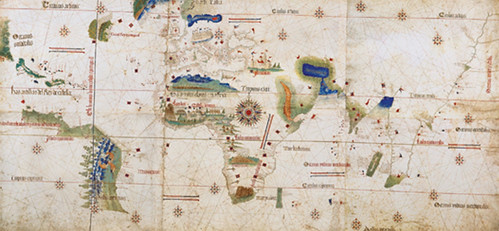First international treaty
The Treaty of Tordesillas was ratified by the Crown of Castile and the King of Portugal in 1494. The treaty divided the newly discovered lands outside of Europe into two equal halves, the east side belonging to Portugal, and the west to Castile (later to become part of Spain). The Mariana Islands were on the Spanish side, thereby giving Spain the right to colonize the Marianas which they did 174 years later in 1668.
It is considered to be the first international treaty of the modern era. Besides the political representatives of Portugal (Ruy de Sousa, Juan de Sousa, and Arias de Almadana) and Castile (Enrique Enríquez de Guzmán, Gutierre de Cárdenas, and Francisco Maldonado), two teams of geographers and experts participated in the negotiation to provide technical assistance in the diplomatic decision.
Origins
The return to Europe of Christopher Columbus on 3 March 1493, was followed by an international conflict based on Portugal’s claim of sovereignty over the newly discovered lands. According to the claim, the discoveries violated the Treaty of Alcáçovas, a previous accord with Castile which granted Portugal control to any “discovery” south of the Canary Islands in the Atlantic Ocean. Castile refused the claim arguing that the discovery of the Americas was made through an expedition going west, not south, from the Canary Islands.
Papal arbitrage was accepted by both countries. Both wanted to secure their access to the Spice Islands (Moluccas, Indonesia) where nutmeg, clove, and pepper grew in abundance. They were highly valuable products, being indispensable for the preparation of medicines, perfumes, and in the preservation of meat.
In the Europe of the 15th Century, the authority of the Pope was regarded as sacred. Pope Alejandro VI, Spanish-born Rodrigo Borgia, had previously issued four “Bulls,” or papal charters. Two of them known as Inter Cœtera, and the others as Eximiœ Devotionis and Dudum Siquidem, established a meridian 100 leagues West of the Cape Verde Islands that would secure the separation of the areas of influence of the two countries.
Portugal would have control over the eastern part and Castile over the western side. The treaty included rights over lands already discovered or to be discovered, but limited to those that did not already have a Christian government. The papal bulls threatened excommunication to those refusing to submit to its mandate. The papal bulls were not in the favor of the Portuguese, who were afraid of losing not only their capacity of influence over undiscovered lands, but also a shortcut route to the Spice Islands. Both Portugal and Castile were hoping to take control of them before the other.
But the other European courts were also concerned about losing the advantages of trading with the Spice Islands, and would eventually refuse papal authority over undiscovered lands. The treaty earned the nickname “Adam’s will” when Francisco I of France demanded to see evidence of “Adam’s will” that excluded him from the claim. The religious movements across Europe in the 16th century can be perceived as a consequence of the political claims of Portugal and Spain.
The treaty was signed in the Castilian town of Tordesillas on 7 June 1494. The kings ratified it on 2 July (Isabel of Castile) and 5 September (João II of Portugal).
Content of the treaty
The treaty established an imaginary longitudinal, from the North Pole to the South, passing by 370 leagues to the west of the Cape Verde Islands, (46º 37´ West longitude). But an agreement on how to identify the exact meridian, for which an exact identification of the longitude was indispensable, was not specified in the treaty.
It was not an easy task by itself: it depended on the exact size attributed to planet Earth. Both courts sent a delegation to the Cape Verde Islands in order to implement the terms of the agreement. The Portuguese wanted to choose the western most island of the Cape Verde Archipelago. The Castilians argued to use the Legua castellana or Castilian league, which was equivalent to 4.18 km, in the measurement of the 370 leagues.
By extending the actual position of the Tordesillas line, Portugal won rights over the easternmost point of Brazil, which she eventually did occupy in 1500 through the expedition of Pedro Alvares Cabral.
The Treaty of Tordesillas was in effect for almost 300 years, with the exception of 1580 to 1640 when the crowns of Spain and Portugal were united. It was superseded in the second half of the Eighteenth Century, by the Treaty of Madrid in 1750 and finally the Treaty of San Ildefonso in 1777.
Both original manuscripts of the Treaty of Tordesillas are kept in the Arquivo Nacional da Torre do Tombo in Portugal and in the Archivo de Indias in Seville, Spain.
For further reading
Davenport, Frances Gardiner, ed. European Treaties Bearing on the History of the United States and its Dependencies to 1648. Washington: Carnegie Institution of Washington, 1917.
Díaz-Trechuelo, Lourdes. “El Tratado de Tordesillas y su proyección en el Pacífico.” Revista Española del Pacífico, no. 4 (1994): 11-22.


